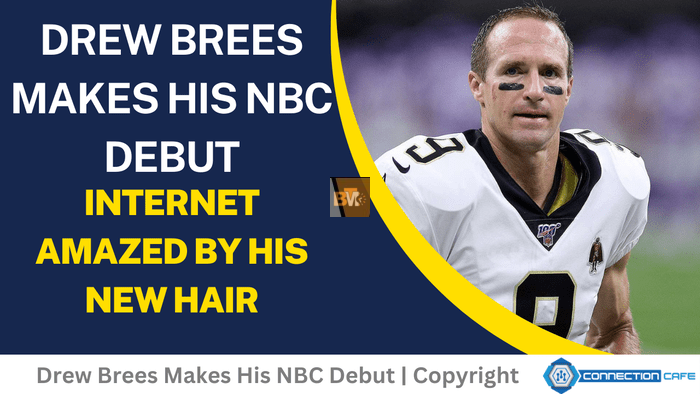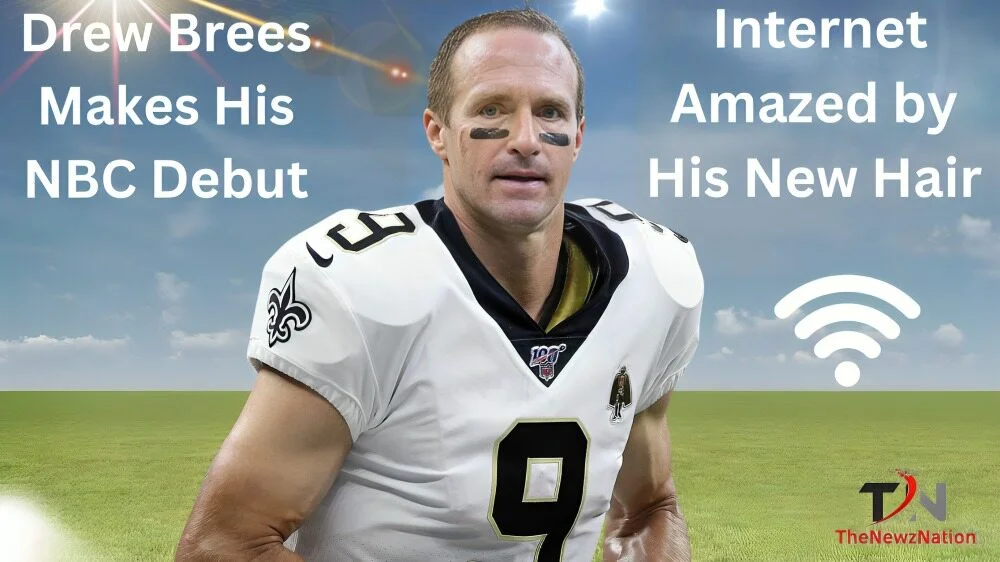Former New Orleans Saints quarterback Drew Brees, a future Hall of Famer and one of the most beloved figures in the NFL, officially transitioned from the gridiron to the broadcast booth in 2021. When it was announced that Brees would join NBC Sports as a football analyst, fans were eager to see how he would perform in his new role. But when he finally made his on-air debut, it wasn’t just his broadcasting skills that got people talking—it was his hair. Social media exploded with comments and memes, and Drew Brees’ new look suddenly became the unexpected topic of the week.
Drew Brees’ Illustrious NFL Career
Before diving into the internet’s reaction to his hair, it’s essential to understand the immense legacy Brees left behind in the NFL. Drew Brees is not just any former quarterback—he’s one of the greatest ever to play the game. Throughout his 20-year career, Brees set numerous records, including becoming the NFL’s all-time leader in passing yards and completions. His precise passing, football IQ, and leadership made him a standout player for the San Diego Chargers (now Los Angeles Chargers) and later, and more significantly, the New Orleans Saints.
When Brees joined the Saints in 2006, the team had just come off a disastrous season and was dealing with the aftermath of Hurricane Katrina. Brees revitalized the team and became a beacon of hope for New Orleans. 2009, he led the Saints to their first-ever Super Bowl victory, earning the game’s MVP honours. Brees’ influence extended beyond the field as he became a crucial figure in the community, engaging in numerous philanthropic efforts and helping to rebuild New Orleans.
When Brees announced his retirement after the 2020 season, it marked the end of an era for Saints fans and NFL enthusiasts alike. However, his retirement wasn’t an end to his public presence—it was merely a transition to a new chapter. His move to NBC was highly anticipated, as fans were curious to see how he would transition from quarterback to analyst. And while everyone expected to be impressed by his football insights, no one expected the buzz that his appearance would generate.
The Transition to Broadcasting
Many former athletes transition from the playing field to the broadcast booth. For some, it’s a natural progression, allowing them to stay close to the sport they love while offering their unique insights and perspectives to fans. However, the transition has its challenges. While athletes like Tony Romo and Troy Aikman have found considerable success as broadcasters, others have struggled to leap.

Drew Brees was a natural candidate for this transition. Known for his analytical mind and deep understanding of the game, he was always seen as a potential star in the broadcasting world. NBC recognized this potential and quickly signed him up after his retirement, offering him a role as a studio analyst for Football Night in America and a game analyst for Notre Dame football games.
Brees was everything fans expected him to be in his first few appearances on NBC. His analysis and insights were sharp, and his ability to break down plays was impressive. However, it wasn’t long before the focus shifted from his football knowledge to something entirely different—his hair.
The New Hair: A Surprising Twist
When Brees appeared on NBC’s Football Night in America for the first time, viewers immediately noticed something different about him. The man known for his closely cropped hair throughout his playing career now sported a fuller, thicker mane. Social media erupted almost instantly with comments, memes, and speculation.
Fans took to Twitter and other platforms to express surprise and amusement at Brees’ new look. Some joked that he must have found the “Fountain of Youth,” while others speculated about whether he had undergone a hair transplant or used some hair restoration treatment. The contrast between his new look and the old, familiar image of the bald or balding quarterback was stark, and it became a hot topic of conversation.
Interestingly, Brees himself didn’t initially address the buzz around his hair. He remained focused on his new role, delivering his football insights with the same precision that defined his playing career. But that didn’t stop the internet from speculating. Memes comparing his new look to various celebrities with famously full hair began circulating, and it became clear that this would not blow over quickly.
The Power of Celebrity and Personal Image
The reaction to Drew Brees’ hair highlights an essential aspect of celebrity culture—the intense scrutiny of personal image. For decades, Brees was known not just for his incredible football skills but also for his signature look, which included his short hair. In sports, especially in the NFL, an athlete’s appearance can become part of their brand. Fans grow accustomed to seeing their favourite players in a certain way, and any significant change can be jarring.
This phenomenon isn’t unique to Brees. Celebrities, especially those in the public eye for extended periods, often face intense scrutiny over their appearance. Whether it’s weight changes, hairstyles, or fashion choices, the public and media quickly notice and comment. For athletes transitioning to new careers, like broadcasting, maintaining a particular image can be crucial as they establish themselves in a new role.

Brees’s reaction to his hair was likely unexpected. After all, his focus was on football analysis, not on his appearance. Yet, in modern media, where social media platforms allow instantaneous and widespread commentary, even the most minor changes can become headline news.
The Science and Business of Hair Restoration
Given the speculation about Brees’ hair, it’s worth exploring the broader context of hair restoration and why it’s such a hot topic, especially for men in the public eye. Hair loss is a common issue that affects millions of people worldwide. For men, the onset of male pattern baldness can begin as early as their twenties, and by the age of 50, a significant percentage of men will experience some degree of hair thinning or loss.
The psychological impact of hair loss can be profound. For many, hair is tied to identity and self-esteem; losing it can lead to decreased confidence. It is particularly true for public figures whose image is constantly under scrutiny. As a result, the market for hair restoration has grown exponentially over the past few decades.
Several methods are available for those looking to restore their hair. These range from noninvasive treatments like minoxidil (Rogaine) and finasteride (Propecia) to more involved procedures like hair transplants. Hair transplants, in particular, have become increasingly popular and advanced, with techniques like Follicular Unit Extraction (FUE) allowing for natural-looking results with minimal scarring.
The hair restoration business is booming, driven by the demand for these procedures among men in the public eye. From Hollywood actors to professional athletes, many have turned to hair restoration to maintain their appearance as they age. Given the speculation about Brees’ hair, he may have undergone one of these procedures, though he has not publicly confirmed or denied it.
The Broader Cultural Conversation
The reaction to Drew Brees’ hair also taps into a broader cultural conversation about ageing, masculinity, and the pressure to maintain a youthful appearance. In our society, there is often a stigma associated with ageing, particularly for men in the public eye. While women have long faced pressure to maintain their looks as they age, men are increasingly subject to similar scrutiny.
This pressure can lead to a focus on maintaining a youthful appearance through various means, including hair restoration, cosmetic procedures, and fitness regimens. The conversation around Brees’ hair is part of this larger discourse, highlighting the expectations placed on men to look a certain way, even as they age.
Moreover, the focus on Brees’ hair underscores the changing attitudes towards male grooming and self-care. In the past, topics like hair restoration and cosmetic procedures were often taboo for men and seen as something that should be kept private. However, as societal norms evolve, more men openly discuss and embrace these options as part of their self-care routine.
Drew Brees’ Response
Drew Brees eventually addressed the buzz light-heartedly as the conversation around his hair grew. During an interview, he acknowledged the attention his hair was getting but didn’t delve into specifics about whether he had undergone any procedure. Instead, he focused on his new role at NBC and his excitement about the next chapter of his career.

Brees’ response was a testament to his character—graceful, humble, and focused on what matters. Rather than getting caught up in the noise, he kept his attention on his work, demonstrating the professionalism that made him successful on the field. For fans, this was just another reason to admire him, and it reinforced the idea that while the internet might be obsessed with his hair, Brees himself was more concerned with his job and his family.
Conclusion: The Lasting Impact of Drew Brees’ NBC Debut
Drew Brees’ debut on NBC was highly anticipated for many reasons—his football insights, his transition from player to broadcaster, and the continuation of his public persona. However, his hair unexpectedly stole the show, reminding us all of the power of personal image in the age of social media.
While the buzz around his hair may eventually fade, Brees’ impact as a broadcaster will likely grow. His knowledge of the game, ability to articulate complex football concepts, and relatable personality make him a valuable addition to NBC’s broadcasting team. Over time, viewers will likely associate him more with his analysis than his appearance, just as they did during his playing days.
In the end, Drew Brees’ NBC debut was a reminder that even the most minor changes can capture the public’s attention, but it also underscored the importance of substance over style. While the internet may have been amazed by his new hair, his talent and dedication will ensure his success in this new chapter of his career.







Leave a Reply